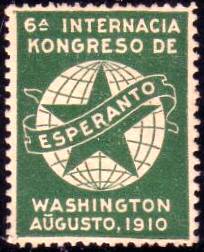by Jill and Dick Miller, Natick, MA, USA
visits since 971118; last updated 150411.

Mi ĝojas, ke vi interesas pri Esperanto. Mi esperas ke vi lernos ĝin, baldaŭ.
(I am happy that you are interested in Esperanto. I hope that you will learn it, soon.)

 Esperanto is the easiest language
to learn -- by far! It also is consistent, expressive, and is used by
millions
of interesting correspondents world-wide. Since 1887, Esperanto
publications
have included books and newsletters on a wide variety of subjects. We
can
lead you to an Esperanto contact point in nearly any country in the
world.
Esperanto is the easiest language
to learn -- by far! It also is consistent, expressive, and is used by
millions
of interesting correspondents world-wide. Since 1887, Esperanto
publications
have included books and newsletters on a wide variety of subjects. We
can
lead you to an Esperanto contact point in nearly any country in the
world.
The Esperanto alphabet is: a,b,c,ĉ,d,e,f,g,ĝ,h,ĥ,i,j,ĵ,k,l,m,n,o,p,r,s,ŝ,t,u,ŭ,v,z.
Because some computers and most typewriters lack some of those characters, alternate versions such as this can be used:
a,b,c,^c,d,e,f,g,^g,h,^h,i,j,^j,k,l,m,n,o,p,r,s,^s,t,u,^u,v,z.
Some put the ^ after
the
letter, and some before (as European typewriters 'set' for a special
character).
Nowadays, the most common alternative notation uses an x after the letter (and a w in place of the ŭ)
instead.
All these conventions work, and become easy to read once you understand
the symbol usage.
Each Esperanto letter has
only
one pronunciation, meaning that if you can read it you can pronounce
it,
and if you can say it you can spell it. Incredible!
a - like a in father.
c - like ts in gets.
ĉ - like ch in chair.
e - like e in eh? (no
diphthong
sound).
g - like g in game.
ĝ - like g in gem.
ĥ - like ch in loch.
i - like i in the music note,
mi, or e in delightful.
j - like y in joy or young.
ĵ - zh like the s in pleasure.
o - like o in oh!
r - slightly trilled like in
Spanish.
s - like the s in sick.
ŝ - like the s in sugar.
u
- like oo in boot.
ŭ - like w in how (usually follows a or e).
All other letters are
pronounced
close enough to English for beginners.
You already know how to pronounce each word, as well, because all Esperanto words are stressed on the penultimate (next-to-last) syllable -- as in "Es-per-ANT-o" (rhymes with Toronto).
Esperanto takes a fairly small number of roots, adding prefixes and suffixes to modify them in a totally standard way for different parts of speech and meanings. The roots are sensibly chosen from the west-European languages. (If you know English and one of French, German, Spanish or Italian you'll recognize most of them.) The plural suffix is always -j (pronounced like the English -y). One of the nicest prefixes for beginners is the use of 'mal-' to reverse the meaning of an adjective -- you only have to learn half as many as in most languages! (E.g., good/bad » bona/malbona; hot/cold » varma/malvarma.) Note that all adjectives end in -a, all nouns in -o, all adverbs in -e, all verbs in -s (-os = future, -as = present, -is = past, -us = conditional) except infinitives in -i and imperatives in -u.
You've never met as
sensible
a language, or one as easy to learn. See how Esperanto 'tames' these
related
words, with their wildly unrelated English sounds and spellings:
dog/dogs/bitch/puppies/pack/canine
» hundo/hundoj/hundino/hundidoj/hundaro/hunda.
horse/horses/mare/foal/herd/equine
» ĉevalo/ĉevaloj/ĉevalino/ĉevalido/ĉevalaro/ĉevala.
So: -in- = female, -id- = offspring, -ar- = group of.
This uniformity and
combining
power enable you to invent a 'new' word for any task, and know that
other
Esperantists will understand:
'female-puppy-like' =
hundidina.
Ĝoju! = Enjoy!
English-Esperanto Online Dictionary (kaj inverse)
Esperanto, the International Language (online resources)
"You say what?! On American campuses, Esperanto is an extracurricular language", by Eva Wolchover (Boston Phoenix, Jan. 8th, 2009)
Esperanto League of North America
Esperanto Music (with lyrics and translator)Welcome to Esperanto (beginner course)
Lernu (Esperanto course, and more)
Getting Started With Esperanto : Kiel Komenci Esperanto (including Esperanto type font info)
The high-liner Gloucester fisherman, "Esperanto" (Can search "Delawana and Esperanto" for more.)